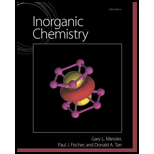
Concept explainers
(a)
Interpretation: The complex with higher N-O stretching frequency needs to be identified from
Concept Introduction: In a coordinate complex, a metal is an electron-rich atom which is surrounded by electron-deficient groups known as ligand. Metal donates electrons to the ligand in these complexes. If electron donation from metal to the ligand increases, the stretching vibration between the atom of a ligand which is directly attached to the metal and the atom further attached to it decreases. If the charge on the metal increases, its tendency of donating the electron increases. This decreases the stretching vibration.
(b)
Interpretation: The complex with the longest N-N bond needs to be identified.
Concept Introduction: In a coordinate complex, a metal is an electron-rich atom which is surrounded by electron-deficient groups known as the ligand. Metal donates electrons to the ligand in these complexes. If electron donation from metal to the ligand increases, the bond length between the atom of the ligand which is directly attached to the metal and the atom further attached also increases.
(c)
The complex with shorter Ta-C distance needs to be identified from
Concept Introduction: In a coordinate complex, a metal is an electron-rich atom which is surrounded by electron-deficient groups known as ligand. Metal donates electrons to the ligand in these complexes. If electron donation from metal to the ligand increases, the stretching vibration between the atom of ligand which is directly attached to the metal and the atom further attached to it decreases. If charge on the metal increases, its tendency of donating the electron increases. This decreases the stretching vibration.
(d)
The complex with shorter Cr-C distance needs to be determined from the given complexes. ‘
Concept Introduction: In a coordinate complex, a metal is an electron-rich atom which is surrounded by electron-deficient groups known as ligand. Metal donates electrons to the ligand in these complexes. If electron donation from metal to the ligand increases, the stretching vibration between the atom of ligand which is directly attached to the metal and the atom further attached to it decreases. If charge on the metal increases, its tendency of donating the electron increases. This decreases the stretching vibration.
(e)
Interpretation: The complex with lowest CO stretching frequency needs to be identified.
Concept Introduction: In a coordinate complex, a metal is an electron-rich atom which is surrounded by electron-deficient groups known as ligand. Metal donates electrons to the ligand in these complexes. If electron donation from metal to the ligand increases, the stretching vibration between the atom of ligand which is directly attached to the metal and the atom further attached to it decreases. If charge on the metal increases, its tendency of donating the electron increases. This decreases the stretching vibration.
Want to see the full answer?
Check out a sample textbook solution
Chapter 13 Solutions
Inorganic Chemistry
- Which is the strongest reductant: Al, Cu, I-, Al3+, Cu2+, or I2? Explain.arrow_forwardDetermine the geometry of the ClF2+ ion using the VSEPR theory. Provide information about the polarity, hybrid type and bond angle of the structure. (Cl: VIIA, F: VIIA)arrow_forwardDraw two linkage isomers of [PtCl3(SCN)]2−.Draw the molecule by placing atoms on the grid and connecting them with bonds. Do not include formal charges and lone pairs of electrons.arrow_forward
- Determine the geometry of the ClF2+ ion using the VSEPR theory. Provide information about the polarity,hybrid type and Bond angle of the structure. (CL:7A,F:7A)arrow_forwardThe correct chemical formula of ammonium dioxalatoplatinate(1l) is: a. (NH4)2[Pt(ox)2] b. (NH4)3[Pt(ox)2]2 c. (NH4)[Pt(ox)2]2 d. (NH4)[Pt(ox)2] Which one of the following compounds has the highest nitrogen-oxygen bond vibrational frequency: 2 a. [Co(NH3)5(NO2)]C12 b. [Co(NH3)5(ONO)]C12 c. NO^+ d. NO2^- When compared to that of the free thiourea, the vibrational frequency of carbon-sulfur bond in [Cu(tu)3]^+ complex is: 3. a. none of these b. the same c. lower d. higherarrow_forwardWhich is more reactive, Fe2+ or Fe3+, and why?arrow_forward
- Use a qualitative MO diagram to explain why the bond in [Li₂] is predicted to be stronger than in [Li₂]+.arrow_forwardHow many M – M bonds are present in [ŋ5- CpMo(CO)3]2? 3 O 1 2arrow_forwardSuggest the most likely geometry for (i) [FeCl4]²- and (ii) [PdCl4]²-. a a. Both (i) and (ii) are tetrahedral b b. (i) is tetrahedral and (ii) is square planar c. (i) is square planar and (ii) is tetrahedralarrow_forward
- Is O2(-3) paramagnetic or diamagnetic?arrow_forwardWhat are the primary and secondary valences of Fe in [FeBr2Cl2(en)]2? Feo: [Ar] 4s? 3d6 +2, +6 +2, +5 -2, +6 O -2, +5arrow_forwardThe bond lengths in Cl2, Br2, and I2 are 200, 228, and 266 pm, respectively. Knowing that the tin radius is 141 pm, estimate the bond distances in SnOCl, SnOBr, and SnOI. Compare the estimated values with the experimental values of 233, 250, and 270 pm, respectively.</o:p> </o:p>arrow_forward
 ChemistryChemistryISBN:9781305957404Author:Steven S. Zumdahl, Susan A. Zumdahl, Donald J. DeCostePublisher:Cengage Learning
ChemistryChemistryISBN:9781305957404Author:Steven S. Zumdahl, Susan A. Zumdahl, Donald J. DeCostePublisher:Cengage Learning
 Chemistry: Principles and PracticeChemistryISBN:9780534420123Author:Daniel L. Reger, Scott R. Goode, David W. Ball, Edward MercerPublisher:Cengage Learning
Chemistry: Principles and PracticeChemistryISBN:9780534420123Author:Daniel L. Reger, Scott R. Goode, David W. Ball, Edward MercerPublisher:Cengage Learning Chemistry: The Molecular ScienceChemistryISBN:9781285199047Author:John W. Moore, Conrad L. StanitskiPublisher:Cengage Learning
Chemistry: The Molecular ScienceChemistryISBN:9781285199047Author:John W. Moore, Conrad L. StanitskiPublisher:Cengage Learning Chemistry: An Atoms First ApproachChemistryISBN:9781305079243Author:Steven S. Zumdahl, Susan A. ZumdahlPublisher:Cengage Learning
Chemistry: An Atoms First ApproachChemistryISBN:9781305079243Author:Steven S. Zumdahl, Susan A. ZumdahlPublisher:Cengage Learning




